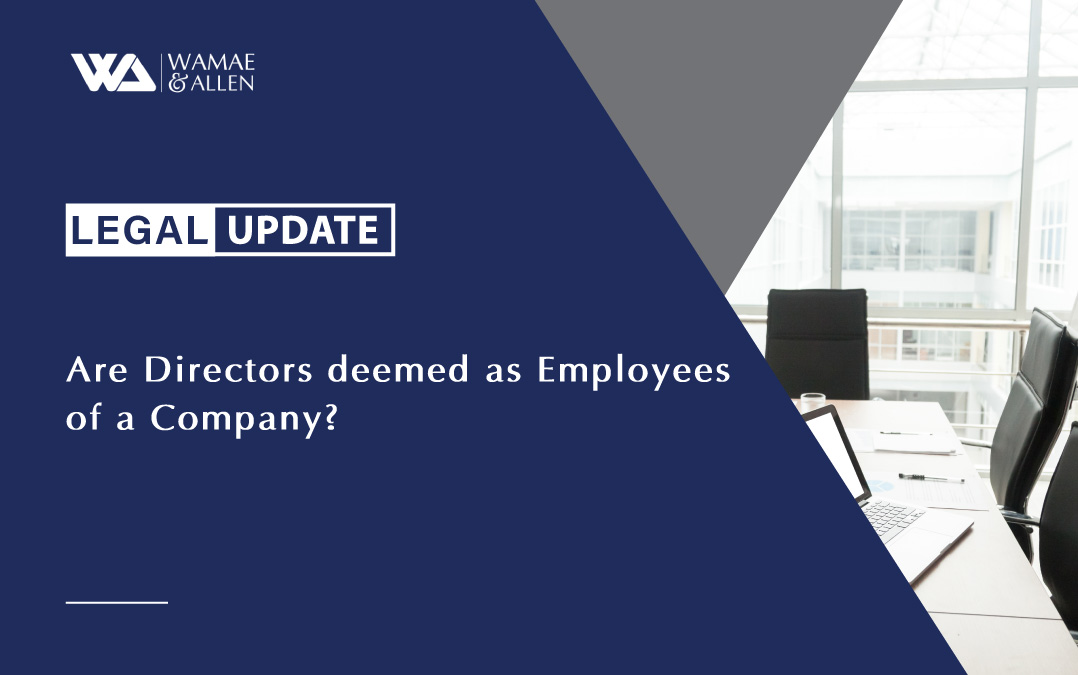 Loading...
Loading...
Justice D.K. Musinga, A.K. Murgor & Dr. K.I. Laibuta in Rift Valley Water Services Board & 3 Others v Geoffrey Asanyo & 2 Others Judgment delivered on 10th June 2022.INTRODUCTION
The certainty of whether a director is an employee of a company is now settled. The terms ‘independent contractor’ and ‘employee’ are mutually exclusive. Contracts with employees entail the placement of employees’ services or productive capacities at the disposal of the employers, thereby enabling the acquisition of the service itself (productive capacity) as opposed to the mere fruits of that productive capacity.
In Contracts for Service, it is not the services as such that are the object of the contracts but the results of those services. In this instance, a client is not interested in the personal service or the labour as such, but in the product or results of such labour.
The foregoing distinction in a pool of many can be lifted from the decision of the Court of Appeal sitting at Nakuru.BRIEF FACTUAL BACKDROP
The 2nd Respondent, the Nakuru Water and Sanitation Services private limited company is a body corporate established pursuant to section 77 of the Water Act, 2016. Section 79(1) of the Act requires the Company to have a Board of Directors nominated to serve in accordance with the Memorandum and Articles of Association (MEMARTS).
The 1st Respondent, Geoffrey Asanyo, was initially appointed to the Board as a representative of the business community for a term of three years which was further extended for a further term of three years. The letter of appointment mandated Asanyo to perform common law set out duties of director. Particularly, he was to attend quarterly Board meetings and was expected to serve as a member of one of the committees in the Board.
By an extraordinary General Meeting held on 19th February 2014, the Company passed a special resolution to amend the MEMARTS to abide by the 2010 Constitution, and had its Board reconstituted. It is at this point that the 1st Respondent, Asanyo, wasn’t appointed.
The 1st Respondent filed a petition to that effect at the Industrial Court at Nakuru seeking among others, orders that the filling of the position was in contravention of Articles 41 and 47 of the Constitution of Kenya. He claimed to be an employee and his term was to end in December 2015, and faulted the dismissal from employment.
The Appellants objected the acceptance of Asanyo as an employee within the meaning of Sections 2 and 3 of the Employment Act, 2007 and section 12 of the Industrial Court Act, 2011 and that the MEMARTS did not confer an employee status.
The appellants lodge an appeal to the Appellate court citing that the trial judge misdirected himself by holding that executive directors were employees of a company within the meaning of Sections 2 and 3 of the Employment Act, 2007 and Section 12 of the Industrial Court Act, 2011.THE RATIO DECIDENDI
The main question was whether the 1st Respondent was indeed an employee of the 2nd Respondent, with a right of claiming in the ELRC Court.
Simply put, the Court held that he was not. Relying on Section 2 of the Employment Act, the Court opined that an employee is one who is employed for wages or salary, including apprentices and indentured learners. Moreover, in the definition of who an employer is, the court buttressed the definition in Section 2 of the Employment Act, as a person that has entered into a contract of service to employ.
The 1st Respondent was neither employed for wages or salary nor was he an apprentice or an indentured learner. There was no contract of service within the meaning of the Employment Act to that effect, and accordingly the Act did not apply in that situation.
The nature of the relationship between Asanyo and the Nakuru Water and Sanitation Services through the appointments was only governed by the Companies Act and the MEMARTS and not the Employment Act.
The Court drove a clear tranche-distinction between an employee and a board member. The court relied on the case of Mc Millan v Guest (1942) AC which held that director is an office holder and isn’t an employee. As per the case of Parsons v Albert J. Parsons and Sons Ltd (1979) ICR, a presumption that a director is an employee must not be made in absentia of the Contract of Service on the engagement terms of the director as an employee of the Company.
Bringing it home, the court held that apart from the appointment letter and extension thereto was not a contract of service. Therefore, the ELRC Court at Nakuru had no jurisdiction to entertain the matter.
IMPLICATION OF THE JUDGMENT
In general, directors who do not have Contract of Service agreements with Companies are not classified as employees. Those who have might be considered. Moreover, this decision for all intents and purposes truncates the fact that non-executive directors in companies are not employees as they play advisory and supervisory roles.
All in all, directors are classified as ‘officeholders’ and not employees for they must fulfill the ‘Contract of Service Condition’ to even be considered as such. This decision proves that directors are normally engaged under Contract for Service as independent contractors by their companies.
This article is provided free of charge for information purposes only; it does not constitute legal advice and should be relied on as such. No responsibility for the accuracy and/or correctness of the information and commentary as set in the article should be held without seeking specific legal advice on the subject matter. If you have any query regarding the same, please do not hesitate to contact Litigation vide litigation@wamaeallen.com










